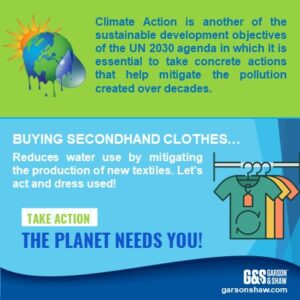World Water Day
World Water Day is an annual event held on March 22nd to raise awareness about the importance of freshwater and sustainable management of water resources. The theme for World Water Day 2023 is “Water for Society: Including All.” World Water Day aligns with SDG #6 “Clean Water & Sanitation” as well as SDG #13 “Climate Action”.
Garson & Shaw contributes to giving used clothes a second life, therefore reducing the demand for new clothing, which results in less water being consumed for the production of new textiles.
If the demand for new textiles is mitigated, then less water is being consumed and/or contaminated. As a result, Garson & Shaw’s work aligns with Sustainable Development Goal #6 “Clean Water & Sanitation” and Sustainable Development Goal #13 “Climate Action”.
The clothing industry has an impact on water resources through the production and processing of textiles. The production of new clothing requires large amounts of water, from growing cotton to dyeing and finishing fabrics. It is estimated that it takes about 2,700 liters of water to produce one cotton t-shirt, and up to 20,000 liters of water to produce one kilogram of cotton fabric. This is because cotton is a highly water-intensive crop that requires large amounts of water for irrigation. In addition, textile production involves several stages that require water, such as washing, dyeing, and finishing. For instance, dyeing and printing are some of the most water-intensive stages of textile production, with estimates suggesting that it can take up to 150 liters of water to dye one kilogram of fabric.
When clothing is discarded, it can also contribute to water pollution if not disposed of properly. Textile production can have a significant impact on water resources and the environment, and efforts are being made to reduce water consumption and improve the sustainability of the industry.
The secondhand clothing industry can help mitigate these impacts by promoting reuse and reducing demand for new clothing production. Secondhand clothing also has the potential to reduce water usage in the textile industry by decreasing demand for new clothing and reducing the amount of water needed for textile production.
Additionally, the secondhand clothing industry can support sustainable water management practices by promoting sustainable water use throughout the supply chain. For example, some secondhand clothing companies have implemented water-saving practices in their stores and warehouses, such as using low-flow toilets and installing rainwater harvesting systems.
Overall, the secondhand clothing industry can play a role in reducing the water footprint of the textile industry. As we celebrate World Water Day, it is important to recognize the important role of water in our society and work towards more sustainable water use practices.





